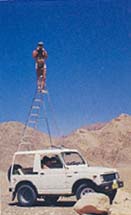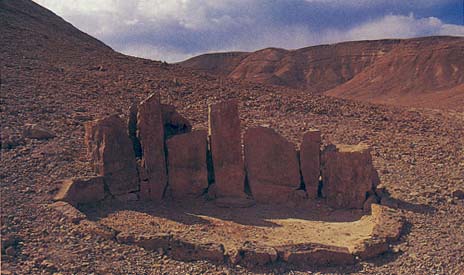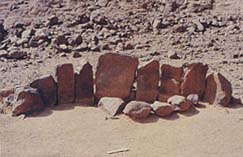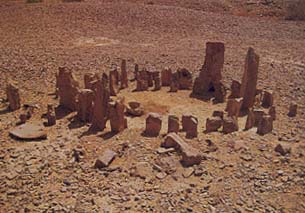No Graven Image? Israelite Aniconism in Its Ancient Near Eastern Context
Tryggve N.D. Mettinger
Coniectanea Biblica, Old Testament Series 42 (Stockholm: Almqvist & Wiksell International, 1995) 252 pp., $27.60
The Iconography of the Canaanite Gods Reshef and Ba‘al: Late Bronze and Iron Age I Periods (c 1500–1000 BCE)
Izak Cornelius
Orbis Biblicus et Orientalis 140 (Fribourg, Switzerland: University Press, 1994) 298 pp., 54 plates, $104
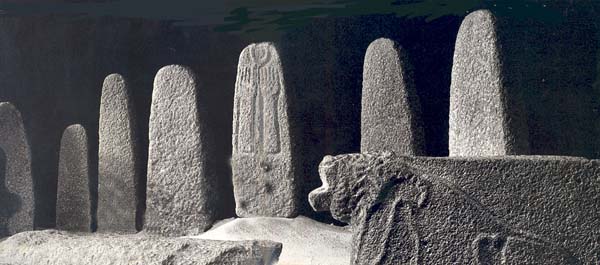
One of the shared features of Judaism, Christianity and Islam is the prohibition on visual representations of God. An explicit ban on divine images appears in the Ten Commandments and in several other passages in the Pentateuch, and the making of idols is reviled in the historical books, the prophets, Psalms and Daniel. Israel’s neighbors, we are told, worship anthropomorphic fetishes of wood and stone, silver and gold, resembling the denizens of the heavens, earth and waters. In moments of backsliding and rebellion, Israel, too, resorts to the abominable practices of her neighbors. The dichotomy between worship with and without idols is sharp, and the Biblical ban is revolutionary.
Or so it would seem!
Tryggve Mettinger brings into question both the notion of a strict dichotomy between Israelite and non-Israelite forms of worship and the revolutionary nature of the prohibition on idolatry. He claims that the Biblical prohibition on the worship of idols and the command to destroy idols (iconoclasm) are a natural outgrowth of an even more ancient practice he calls “aniconism.” In aniconism, deities are visually represented, though without the use of pictorial, human or animal images. Although aniconism can coexist with idolatry, it is usually an alternative to that more widely known practice.
According to Mettinger, aniconism takes two basic forms. In “material aniconism” a god is represented by some physical object, usually a shaped stone or stone pillar. The god either inheres in the object or is alluded to by the object. In “empty-seat aniconism” the presence of the divinity is indicated by the provision of a resting place for the god, such as a throne, pedestal or animal mount. The god does not reside in the object itself but, rather, exists only in close proximity to the object.
There are numerous Israelite examples of both types of aniconism. The stone pillars (masseboth) found at Arad, the pillars erected by Jacob at Bethel (Genesis 35:14) and the pillars to be set up in Egypt according to a prophecy of Isaiah (Isaiah 19:19) are all instances of material aniconism. In the Jerusalem Temple, however, empty-seat aniconism was the norm, with cherubim providing a throne for an invisible God (Exodus 25:22).
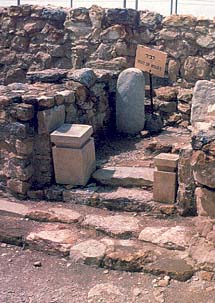
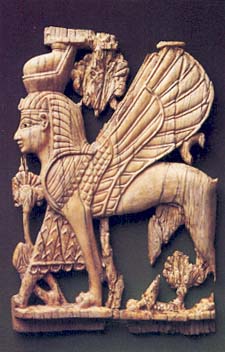
The bulk of Mettinger’s book examines textual and archaeological evidence showing that aniconism, primarily material aniconism, was widespread in the ancient Near East. Working backward through time, Mettinger finds that sacred stones were used to represent the divine among the pre-Islamic Arabs and the Nabateans, in the Punic colonies and their Phoenician homeland, in Iron Age Judah and Israel, in Syria and Lebanon of the late second millennium B.C.E., and in pre-Israelite Canaan; in the Negev, stone pillars were set up as early as the 11th millennium B.C.E. Mettinger meticulously registers, studies and evaluates stelae and rocks depicted on coins and seals, shaped stones found at excavated sites of certifiable cultic character, temples with stone pillars referred to by Greek and Roman historians, “houses of god” (or betyls, related to the Hebrew
Especially prominent is evidence provided by Israeli archaeologist Uzi Avner, who for many years motor-biked across the Sinai and Negev deserts, identifying and documenting scores of prehistoric sites containing stone pillars. This material permits Mettinger to trace Israelite aniconism not to its neighbors or predecessors in Iron Age Canaan but to its own desert heritage, influenced by the Midianite and the Kenite cultures during the late second millennium B.C.E.a (In a time when many scholars are denying more and more of the Bible’s statements about Israel’s origins and assigning them to later and later periods, sometimes even to the early Hellenistic period [332–167 B.C.E.], this evaluation is noteworthy and refreshing.)
Mettinger’s clearly written and amply illustrated book goes a long way toward finding a context for the Biblical evidence concerning the legitimate use of, and the eventual ban on, masseboth. He makes a convincing case that both material aniconism and, to a lesser degree, empty-seat aniconism were hallmarks of northwest Semitic religions in general and pre-Deuteronomic Israelite beliefs in particular.b These practices may have been even more widespread than the use of anthropomorphic cult statues (such as the Ba‘al and Reshef images below).
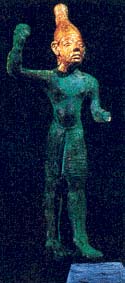

Nonetheless, it is questionable whether these passive forms of aniconism led to the more active iconoclasm. Mettinger writes that “the express prohibition of images is just the logical conclusion of a very long development.” It is true that there was an understandable reduction in the number of masseboth in monotheistic Israelite religion, but there was no essential change in aniconism, so that one can hardly speak about a “very long development.” As far as we can tell, the practice of setting up standing stones 13 thousand years ago was nearly the same as it was 2 or 3 thousand years ago; stone aniconism was about as inert as the stones themselves (11 millennia is a long time by anyone’s standards). So we must still look for some outside influence that changed the stones from legitimate means of divine worship to abominations.
Mettinger also dodges the question of what the stones actually represent, an unavoidable question when trying to understand why stone worship was eventually deemed unacceptable. Archaeology provides evidence for the existence of aniconism, but other disciplines, such as theology or the history of religion, must be called upon to proffer explanations. It seems to me that the perception (correctly or incorrectly attributed by the Bible to idolaters) that the deity was immanent in both idols and stones contributed to their eventual ban. It is precisely this factor that distinguishes, contra Mettinger, material aniconism from empty-seat aniconism. We should remember that in Israelite religion material aniconism (the use of a standing stone, say, to represent Yahweh) was prohibited along with anthropomorphic idolatry, but empty-seat aniconism remained a perfectly legitimate form of worshiping Yahweh. The hardening of religious attitudes, leading to full-blown iconoclasm, may have come about for political reasons linked to the reforms of Hezekiah (after 715 B.C.E.) and Josiah (after 622 B.C.E.). These reforms were intended to centralize worship in Jerusalem (where empty-seat aniconism was practiced) and to delegitimize cults outside of Jerusalem (where masseboth were used).
In any event, a fundamental distinction must be drawn. Idolatry and material aniconism imply that the divine can inhere in a physical object; this notion derives from the widespread belief that gods are numinous forces or beings immanent in, or even identical to, natural phenomena. Empty-seat aniconism, however, leaves the deity free, unattached and ultimately transcendent. Both types of aniconism localize divinity for the purposes of worship, but they make fundamentally different assumptions about the nature of the divine. For this reason, we cannot accept Mettinger’s equation of the masseboth at Arad with the cherubim in the Jerusalem Temple. True, they are both aniconic, but they signify different ideas of divinity. The reformers of the Priestlyc and Deuteronomic schools, each in their own way, realized this. Mettinger has not.
Representation of deities, in the more familiar, anthropomorphic sense, is also the subject of Izak Cornelius’s book, which examines iconographic sources relating to two major Northwest Semitic deities, Reshef and Ba‘al. Cornelius focuses on the second half of the second millennium B.C.E., when Egypt ruled the Levant and readily adopted the deities of its neighbors. Most of the evidence comes from Egypt, although other areas are represented.
Text-centered studies indicate no connection between Reshef and Ba‘al, apart from their being among the Canaanite gods worshiped in Egypt—either by their own names or in the guise of Egyptian counterparts. Why, then, are the two gods brought together under a single cover? The reason for studying them in tandem is that ancient iconography depicts them in similar ways; the two gods are often posed with an arm raised, so that each has been characterized as a “striking god” or, preferably, a “menacing god.”
This study strives to present criteria for distinguishing between the two gods in cases where there are no texts. The work also aspires to use iconographic evidence to enhance our knowledge of the deities, adding information about their characters not apparent from texts.
Most of the book is a descriptive catalogue of all known visual images of the two gods. Casting a much wider net than all previous studies, Cornelius draws upon two-dimensional media, such as reliefs, seals and amulets, as well as on three-dimensional bronzes, pottery and statues. He discusses the Reshef and Ba‘al individually and separates representations showing the gods both with arm raised and with arm lowered at the side. Each entry in the catalogue includes a bibliography of previous publications and studies, along with a commentary on the scenes and deities presented. Where a text is inscribed upon an item, Cornelius provides both transliteration and translation. Photographic plates and drawings make all the evidence available in convenient form.
One of Cornelius’s significant conclusions is that Reshef, who has always been considered a god of plague, paralleling the Mesopotamian gods Nergal and Erra, actually appears in the iconography as a benevolent god of healing and a protector of life. Reshef’s arm is raised in a gesture of menace toward his worshipers’ enemies, while the other, lowered arm often bears a protective shield. Ba‘al, on the other hand, always holds a plant spear in his raised arm, making him a bringer of life.
Cornelius is to be thanked for his meticulous analysis of a large corpus of valuable material presented in a comprehensive and intelligible format. He has provided a valuable resource for archaeologists and scholars of religion and art history. He has also laid out guidelines for working with iconographic material.
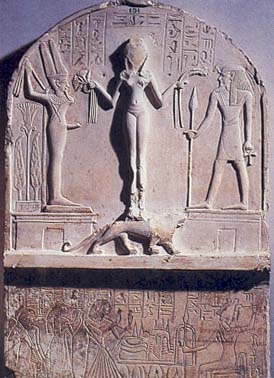
Yet is it true, as Cornelius claims, that iconographic depictions “can fulfill a role comparable to the texts from Ugarit”? The nearly 150 items that Cornelius considers have yielded very little new information about the two gods. Also, in the final account, it is the texts accompanying the pictures that provide the decisive clues for identifying the gods and their attributes. Purely iconographic analysis leads as far as the conclusion that a raised hand, with or without a weapon, is a symbol of some kind of power. Only the texts describing Reshef as a god who listens to prayers and who heals inform us that Reshef’s power is an apotropaic power—an ability to ward off disease.
The impotence of purely iconographic analysis is illustrated by several reliefs showing Reshef, both arms lowered, standing with a naked goddess, Qudshu, and an ithyphallic god, Min. These erotic scenes defy explanation, precisely because no text indicates any erotic aspect of Reshef. Cornelius suggests that in these cases, too, Reshef is a protector, but such an analysis isolates him from other scholars and ignores the rest of the picture. What is Reshef protecting? In this case, as in others, a word is worth a thousand pictures.
MLA Citation
Footnotes
Memories of early contacts between Israel and the Midianites (a people that occupied southern Transjordan) and Kenites (a people of the desert near Sinai) appear in various Biblical traditions, such as the reports of Moses’ marriage to a daughter of Hobab, who is called a Midianite in Numbers 10:29 and a Kenite in Judges 4:11.
The so-called Deuteronomic school was responsible for the composition and editing of the Book of Deuteronomy, the Former Prophets and possibly some of the prophetic books. This school flourished from the time of Josiah until the Babylonian Exile (late seventh century to mid-sixth century B.C.E.). Its main doctrines include centralization of the cult, a total ban on idols and religious practices considered Canaanite, and recognition of the Temple as the main locus of divine presence.
The Priestly school composed much of the Pentateuch (other than the Book of Deuteronomy) and Joshua. The date of this school’s activity is still the subject of scholarly controversy. Most authorities place it during the Exile or in the early post-Exilic period (sixth to early fifth century B.C.E.), while others date it to the time of Hezekiah (late eighth century B.C.E.). Its main concerns were the proper performance of the cult, the purity of the nation and Land of Israel, and the maintenance of the Temple.


